
The Global Sleep Apnea Problem
Sleep apnea is far more common than most people realise. Around 1 billion people worldwide are affected, but up to 90% go undiagnosed. This is a statistic that I encounter in practice all the time.
Many patients ignore the signs — loud snoring, gasping during sleep, or excessive daytime tiredness — assuming these symptoms are harmless. However, untreated obstructive sleep apnea (OSA) can lead to serious health problems like heart disease, stroke, depression, and cognitive decline.
Why Traditional Tests Aren’t Enough
The gold standard for diagnosis is the overnight polysomnography (PSG) test. But it requires special equipment, trained staff, and a hospital or sleep lab — resources not easily available in many places.
To make screening easier, doctors often use questionnaires like STOP-BANG. While it’s good at catching people who might have OSA, it also produces a lot of false alarms. It’s sensitive, but not specific.
We need something better — accurate, accessible, and scalable.
What If We Could Diagnose OSA Using Sound?
That’s where our recent study comes in. I was fortunate to be part of a multi-centre research team that explored a bold question:
Can artificial intelligence (AI) diagnose sleep apnea using just the sound of snoring?
The idea is simple. During sleep, your snoring and breathing patterns carry acoustic signatures. AI can be trained to recognise these subtle patterns and distinguish between normal and abnormal breathing.
Inside the Meta-Analysis
In our newly published Bayesian meta-analysis (appearing in CHEST journal), we analysed 16 studies that used AI to detect OSA based on sound recordings. These studies covered over 7,000 participants and tested 41 different AI models.
Each model was trained to predict OSA by comparing audio recordings to the apnea-hypopnea index (AHI) — the standard measurement used in sleep studies.
What the Data Showed
The results were impressive. AI achieved a pooled sensitivity of 90.3% and a specificity of 86.7%.
In simpler terms, these models correctly identified people with sleep apnea 9 out of 10 times — and they were almost as good at ruling it out. Not only that, the performance was consistent across mild, moderate, and severe forms of sleep apnea.
Even more encouraging, we found that smartphone recordings at home worked just as well as recordings made with lab equipment. This opens up enormous potential for remote and accessible sleep screening.
Why This Could Be a Game-Changer
This technology could help bring sleep apnea screening to places that have no access to sleep labs. It could also help primary care doctors and surgeons decide who needs further testing — without the burden of unnecessary referrals.
AI sound analysis won’t replace formal sleep studies. But it might become the first line of screening, especially in high-risk or underserved groups. And it could all happen from the comfort of a patient’s home.
A Personal Reflection
Being part of this research has been a deeply rewarding experience. I’m grateful to my co-authors for including me in this important work. Collaborating across disciplines reminded me how much more we can do when we combine clinical insight with innovation.
I hope that my input to the study added real value.
Read the Full Study
If you’d like to explore the details, you can read the full article in CHEST here:
The Future of Digital Sleep Medicine
As digital tools evolve, we may be able to screen for sleep apnea with nothing more than a smartphone and an app. That future is closer than we think.
And it might start with something as simple — and often overlooked — as a snore.
For more information, kindly visit our sleep apnea specialist


Comments are closed